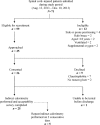Feasibility and Acceptability of Implementing Indirect Calorimetry Into Routine Clinical Care of Patients With Spinal Cord Injury
- PMID: 29339868
- PMCID: PMC5108511
- DOI: 10.1310/sci2016-00001
Feasibility and Acceptability of Implementing Indirect Calorimetry Into Routine Clinical Care of Patients With Spinal Cord Injury
Abstract
Background: In the absence of reliable predictive equations, indirect calorimetry (IC) remains the gold standard for assessing energy requirements after spinal cord injury (SCI), but it is typically confined to a research setting. The purpose of this study is to assess the feasibility and acceptability of implementing IC into routine clinical care in an Australian SCI rehabilitation facility. Methods: Bedside IC (canopy hood) was performed, and patients completed an IC acceptability questionnaire (open-ended; yes/no; 5-point Likert scale). Fasted resting energy expenditure (REE) steady-state criteria were applied to assess data quality, and adherence to a test ≥20 minutes was recorded. Staff were surveyed to assess impact of IC on usual care. Results: Of 35 eligible patients, 9 declined (7 reported claustrophobia). One patient could not be tested before discharge and 25 underwent IC (84% male, injury level C2-L2, AIS A-D). Anxiety prevented one patient from completing IC, while another failed to fast. The remaining 23 patients achieved a steady-state REE (≥5 consecutive minutes with ≤10% coefficient of variation for VO2 and VCO2). Test-retest (n = 5) showed <10% variation in REE. Patients deemed the procedure acceptable, with 88% reporting a willingness to repeat IC. Eighty percent of patients and 90% of staff agreed it was acceptable for IC to be integrated into usual care. Conclusion: This study found that IC is a feasible and acceptable addition to the routine clinical care of patients recovering from SCI and may serve to improve accuracy of nutrition interventions for this patient population.
Keywords: energy expenditure; feasibility studies; indirect calorimetry; nutritional requirements; spinal cord injuries.
Figures


References
-
- Buchholz AC, McGillivray CF, Pencharz PB.. Differences in resting metabolic rate between paraplegic and able-bodied subjects are explained by differences in body composition. Am J Clin Nutr. 2003; 77( 2): 371– 378. - PubMed
-
- Hayes M, Chustek M, Wang Z, . et al. DXA: Potential for creating a metabolic map of organ-tissue resting energy expenditure components. Obesity Res. 2002; 10( 10): 969– 977. - PubMed
-
- Monroe MB, Tataranni PA, Pratley R, Manore MM, Skinner JS, Ravussin E.. Lower daily energy expenditure as measured by a respiratory chamber in subjects with spinal cord injury compared with control subjects. Am J Clin Nutri. 1998; 68( 6): 1223– 1227. - PubMed
-
- Jeon JY, Steadward RD, Wheeler GD, Bell G, McCargar L, Harber V.. Intact sympathetic nervous system is required for leptin effects on resting metabolic rate in people with spinal cord injury. J Clin Endocrinol Metab. 2003; 88( 1): 402– 407. - PubMed
-
- Cox SA, Weiss SM, Posuniak EA, Worthington P, Prioleau M, Heffley G.. Energy expenditure after spinal cord injury: An evaluation of stable rehabilitating patients. J Trauma. 1985; 25( 5): 419– 423. - PubMed
MeSH terms
LinkOut - more resources
Full Text Sources
Other Literature Sources
Medical
Miscellaneous
